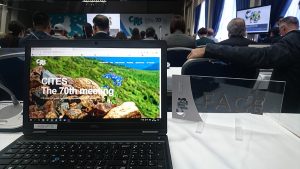
11 Oct 2018 CITES Standing Committee: last preparations for the Conference of Parties
The Convention in International Trade in Endangered Species (CITES) concluded its meeting of the Standing Committee on 5 October 2018. The meeting saw a packed agenda, with important topics like quota for Leopard hunting trophies and the involvement in CITES of local communities and their livelihoods. This was also the last meeting before the CITES Conference of Parties (CoP), in May 2019.
Leopard hunting quota
Last July the CITES Animals Committee, and now the Standing Committee, reviewed the quota for Leopard hunting trophies, established under the CITES CoP, and re-affirmed the sustainability of the quota of the following countries: Mozambique, Uganda, Namibia, South Africa, Tanzania, Zambia and Zimbabwe. Three countries could not be reviewed: Central African Republic, Ethiopia, Botswana. The Standing Committee decided to give them until the CoP in 2022 to submits documents for review.
FACE, together with its members Safari Club International, Safari Club International Foundation and Conservation Force intervened, supporting the countries in the review and outlining future support of hunters for the conservation and management of Leopard in Africa. They were also critical of plans to have a review of all the quota for Appendix 1 listed species in CITES, which would create an extra burden for authorities and will take more resources, which can be better used for conservation on the ground.
Local communities and their livelihoods
Not addressing the needs of local communities who are living with conflict-causing wildlife diminishes all the efforts of authorities to manage and conserve wildlife in countries around the world. That is why countries decided at the last CoP in South Africa to see how local communities and their livelihoods could be better incorporated in CITES and its decision-making.
Namibia lead this effort in the past 2 years, but at this Standing Committee this was threatened by countries that do not see the need of these activities within CITES. Although international conservation would highly benefit from the inclusion of local communities, it is now uncertain whether CITES can make this step in the right direction. Hopefully the next CoP can create leadership in this regard.



